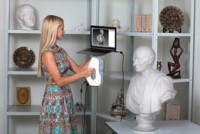Exact Metrology: How 3D Scanning Can Be Used In Industrial Settings
3D scanning is currently relied on across many industries for essential processes. Some of these industries and functions include aerospace, automotive production, medical technologies, and architecture. Exact Metrology understands the ins and outs of the scan process along with the many advantages 3D scanning offers in industrial settings. While the ways in which you use 3D scanning in your particular industry will vary, in this blog we explore just three of the most versatile and interesting ways we see 3D scanning being employed across industries.
Quality & Performance Testing
One of the most common ways 3D scanning technology can be used across industrial settings is for quality and performance testing. The realm of quality inspection is one in which 3D scanning has greatly improved and streamlined.
Creating Virtual Conditions
3D scanning allows those in industrial environments to capture high-resolution, fine details through photo detail capturing that is tied to the scan data. With this plethora of data, a virtual condition with precise detailing can be created. This reality capture then allows a user to conduct a virtual walk-through of an exciting environment and locate potential hazards.
For example, you might use the reality capture data to simulate the relocation of a heavy piece of equipment and determine what will be affected in the surrounding environment. Through such data analysis, you might find that pipes or electrical wiring will also need to be moved. And, more broadly, capturing a 3D scan of an entire empty warehouse allows for the rendering of empty canvas mockups that can be used to preview the placement of future equipment, safety walkways, and any other strategic infrastructure.
Archival Purposes
The opportunities for archival documentation in industrial settings are endless when employing 3D scanning reverse engineering. In addition to opportunities for planning and analysis, the digital capture of a workspace, as described above, also allows for more thorough archival documentation of those sites as well as manufactured products and component parts.
These archivable snapshots of spaces and physical objects can be referenced in the future evaluation of historical data. For example, this employment is already common in the nuclear world where a plant shutdown can be a very costly endeavor. 3D scanning allows for quick capturing of the space without delay or disruption of engineering and planning for improved safety and enhancements. Additionally, plant managers can validate possibly undocumented changes, such as pipes that have been rerouted around a beam or the addition of a new electrical drop.
Long-range scanning can easily capture large facilities with their ability to document hundreds of thousands of square feet across a wide range in a day. As companies expand and contract their operations for a variety of reasons, access to 3D scanning that can document these changes for archival purposes and easy reference down the road becomes increasingly necessary.
Learn More About The Use Of 3D Scanning Across Industries
In summary, 3D scanning has become a common feature in many industrial and manufacturing settings and is used for many essential tasks. 3D scanning technology can certainly push your operations to the next level, allowing for more rapid and safe production as well as archival documentation for future reference. This option for expanding your digital archive will certainly set you up for success in any rapidly evolving industry in which change is the norm.
This content was originally published on the Exact Metrology website.

